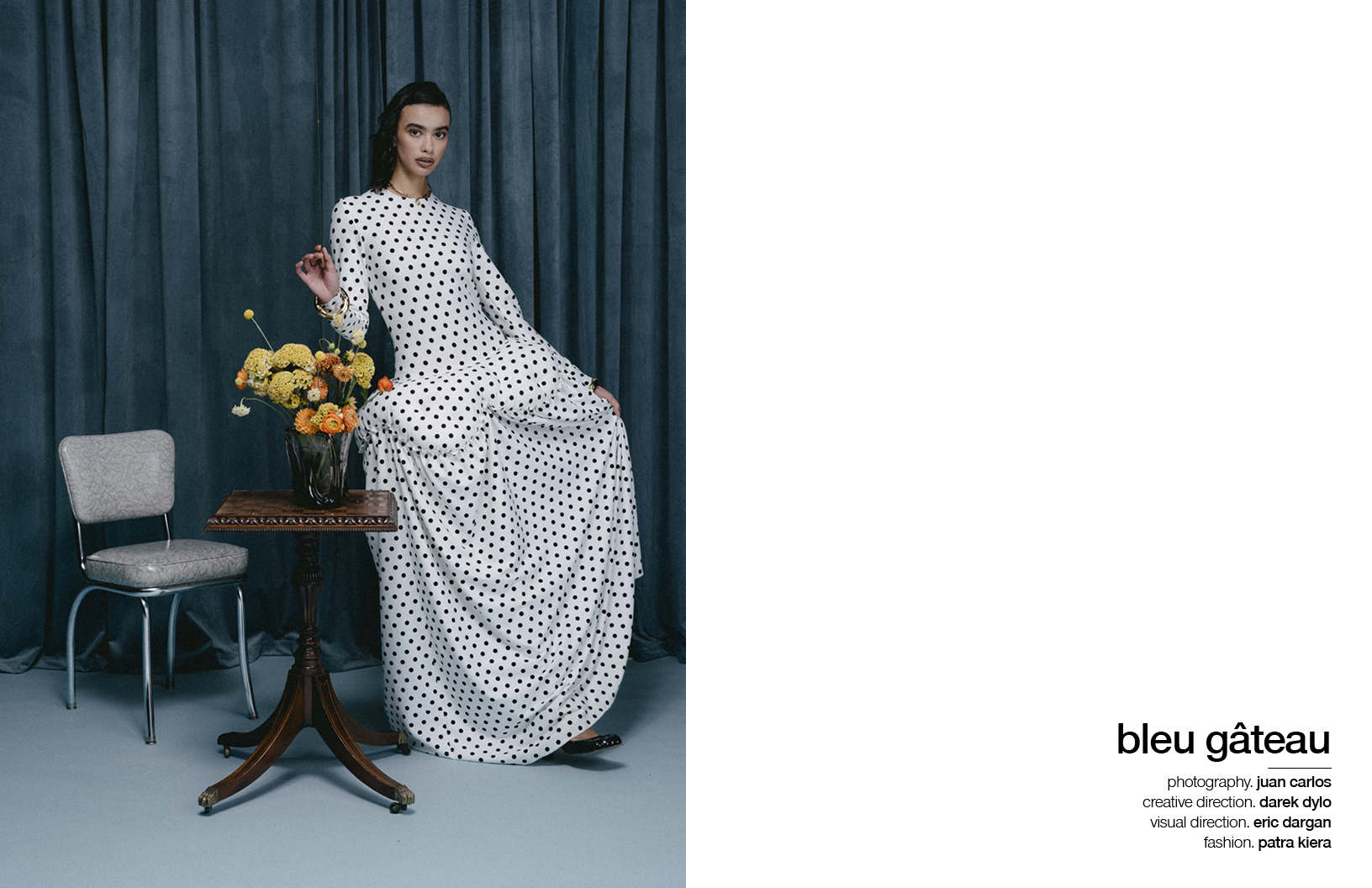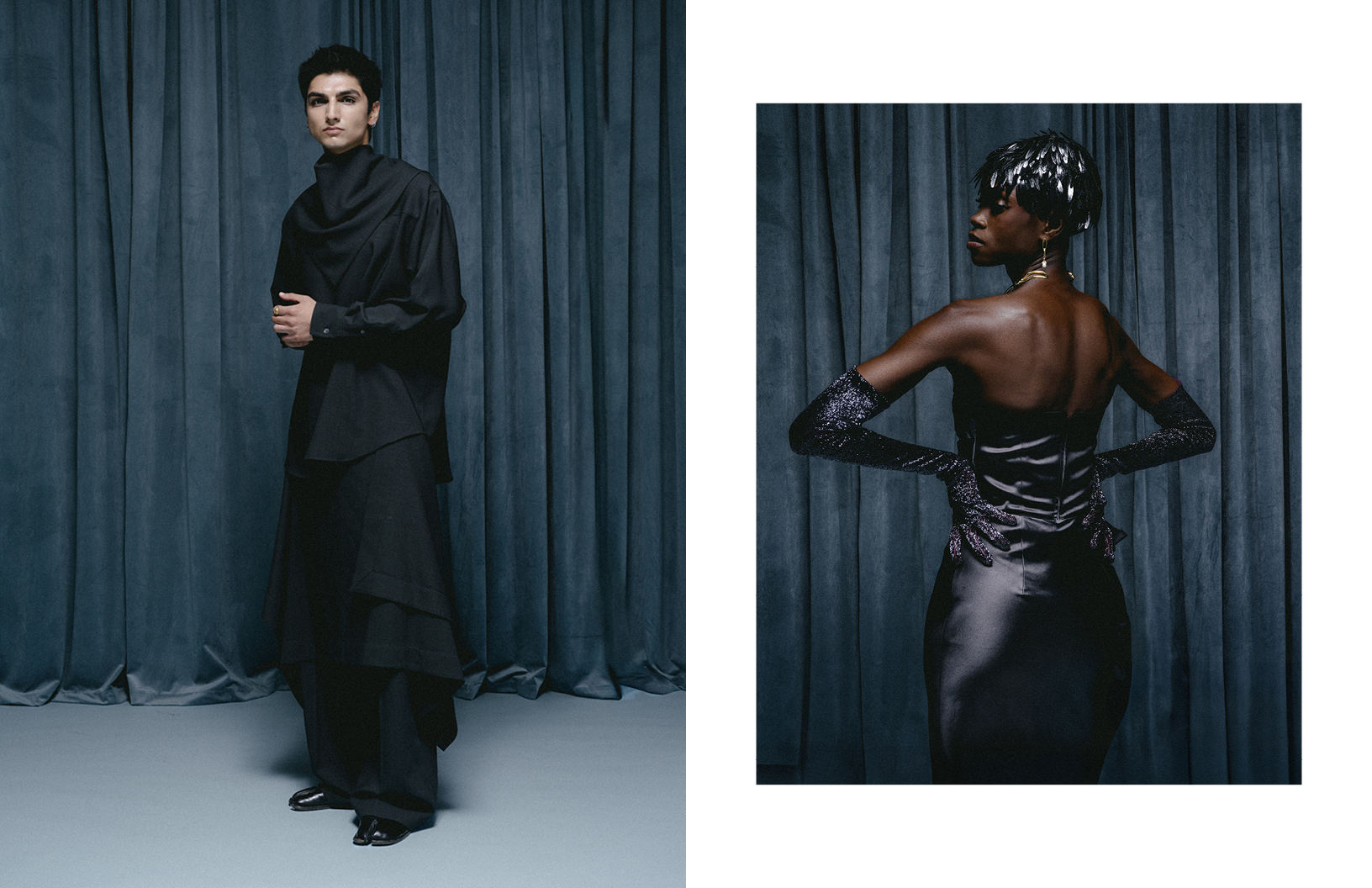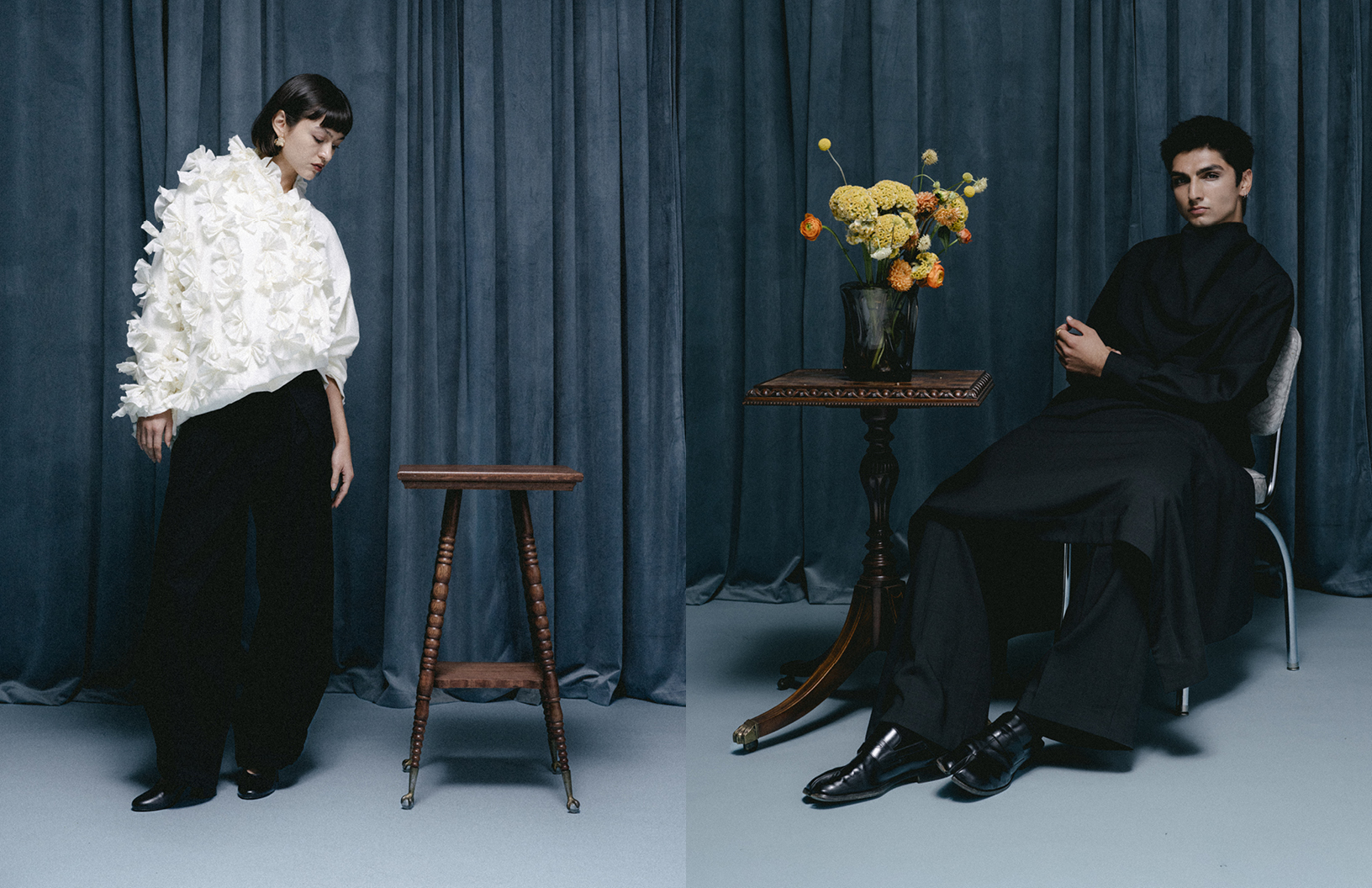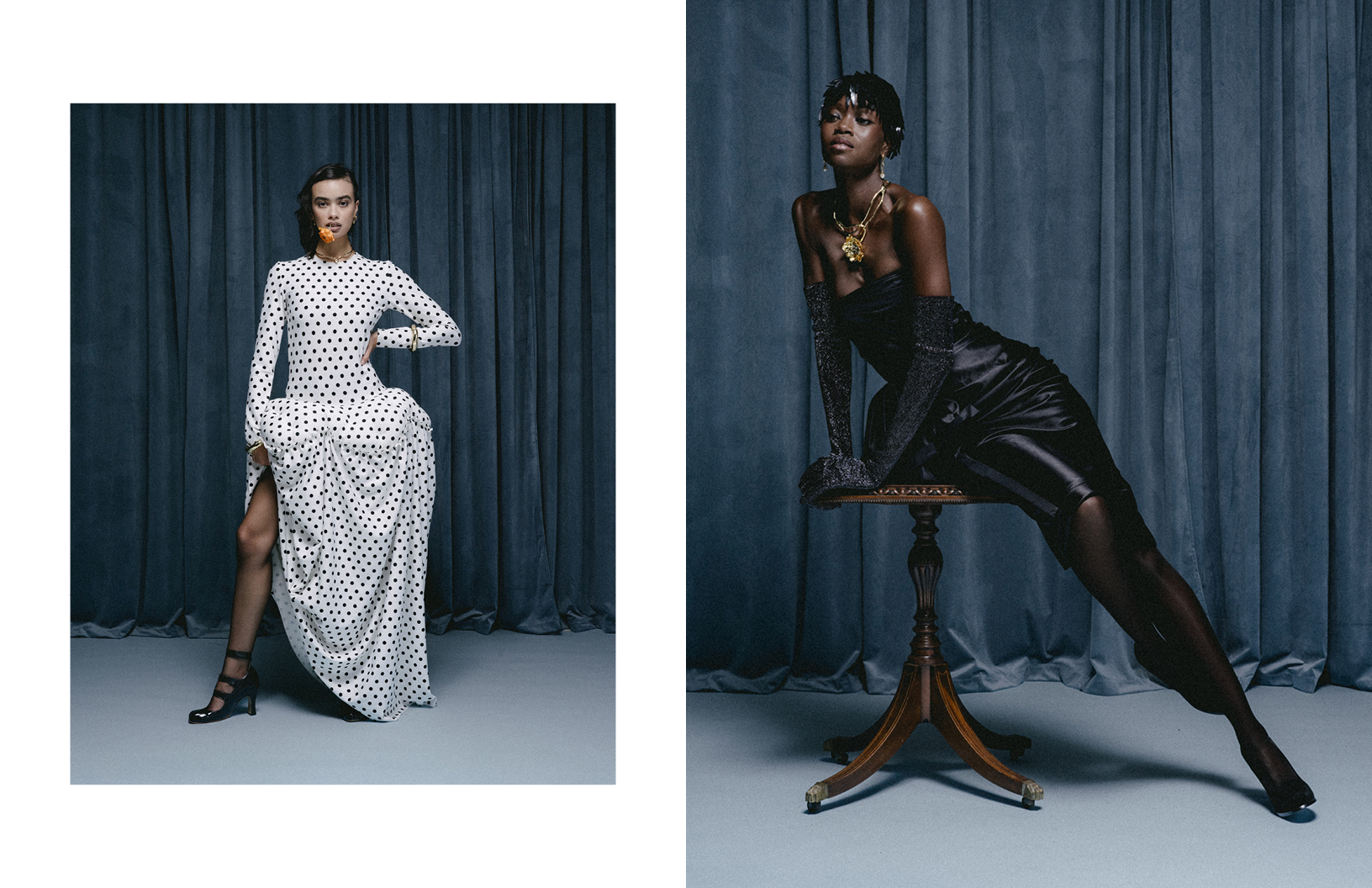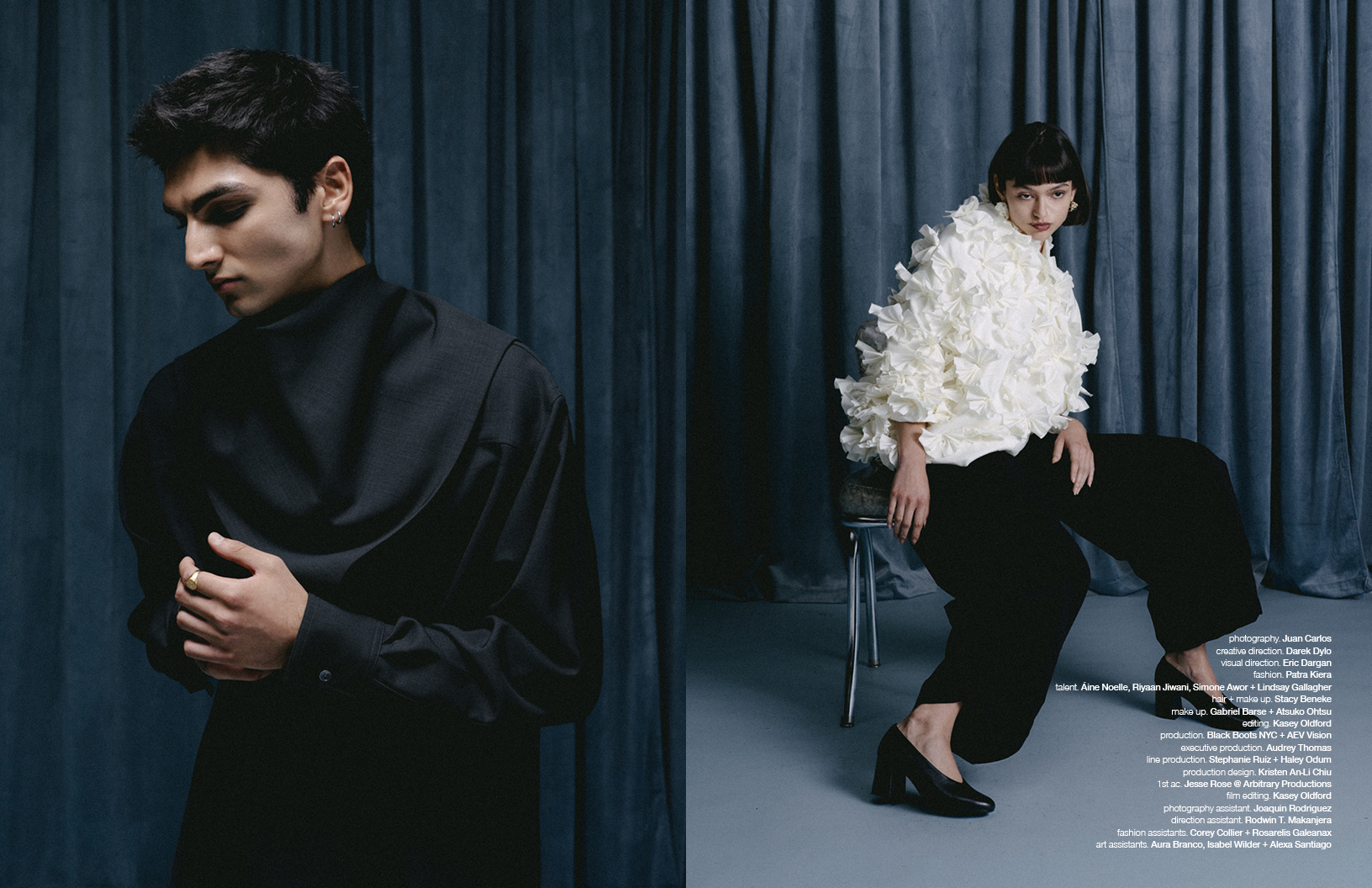Blending the influences of each of their unique histories, April Ru Wan and Jessica Pan come together to bring The Sirens Cry to Schön! — an imagined story of what a world post-climate change might look like. For this piece, Schön! spoke to both Wan and Pan about the design process, how this project came together, and what the two have planned for the future.
April, you spent your childhood in Vancouver and your teenage years in Shanghai. How do you think that history across two nations affects your work?
I’m definitely inspired the easiest by my surroundings. I see my childhood in Vancouver reflected the most within my work ethic. There’s no denying that the west coast holds a gentler atmosphere compared to cities on the east. The way I choose to approach my work is quite similar to how Vancouver operates as a city. I typically go through countless forms of experimentation with focal points of the piece in a calm manner. Through my experience, the more time I give myself to observe the variations of approaches that I can bring to my projects, the easier the visual execution would be. I’ve been residing in Shanghai for the past year now due to travel restrictions for Covid-19. Based on some projects that I’ve shot for my website recently, it’s quite easy to distinguish the heavy influence inspired by the city. I gather the references that I build off of from various parts of Shanghai, from the distinctive architectural difference in Old Xuhui in contrast to Xujiahui to the mundane routines of Shanghainese elders. I trust that I will never run out of new discoveries in this city. Shanghai possesses an energy that is often mirrored by its local residents.
You’ve said this piece tells the story of an extraterrestrial character. Can you explain this story in more detail? How does this story connect to our present moment?
The Sirens Cry is a visual story depicting the damage to marine life due to climate change. I remember around last November I was walking to my university’s library when I ended up passing by the Extinction Rebellion strike that was near Oxford Circus. There were helicopters in the sky flying dangerously low with seas of people marching in the rain, demanding the rest of the world recognise the damage that we have done to our planet. Witnessing the Extinction Rebellion protest was what opened my eyes to our climate crisis. This collection of photographs visualises a story of an extraterrestrial character representing mother nature on planet Siren, a planet where marine life is facing the damages that earth is currently suffering from. She spends her days endlessly protecting the species that inhabit her planet. When discussing the damage of climate change, the first thing that comes to people’s mind is usually the melting ice caps or the wildfires currently destroying mass amounts of land around the globe. I rarely hear discussions on the damage climate change has done to our oceans. The heatwaves that we humans experience are also experienced by sea-life. The oceans’ temperature growth disrupts the typical functions of immense ecological habitats. According to a study by the National Academy of Sciences, the world’s oceans are expected to lose one-sixth of their species and marine life by the end of this century if we do not take action.
From a creative directing standpoint, how did you picture the imagined world of Siren? What steps did you take to realise that vision for the photos?
My main source of inspiration for this shoot was to base the set on of the types of surroundings I was experiencing when I came across the climate strike. I imagined the planet Siren to vibrate an airy post-apocalyptic energy. The challenging part was figuring out how I was going to fill the set with water while simultaneously preventing permanent damage to the studio. I often work with a carpenter who helps me construct the technical parts of my set designs. The way it was done was by using wood to build a barricade along the perimeter of the set, creating a pool-like structure. Then, he laid down a heavy-duty waterproof material that would prevent the water from leaking through the flooring. Lastly, the pool was filled with 4.6 tons of water in order to reflect on the current crisis of rising sea levels on earth. This step was the most time consuming; it ended up taking 12 hours to transfer the water in and out of the pool.
You’ve said you’re very hands-on with your props. Can you tell us more about why that is? What prop work was involved in this shoot?
Most times when you envision something in your mind, it can be frustrating when the outcome isn’t identical. I always treat my initial idea as a starting point, never basing the final product off of that. Once I start making a mind map and jotting down everything that comes to mind in relation to the topic, I’ll start polishing the concept. I will end up with a final concept that is a bricolage of extensive layers strung together by my initial starting point. For this specific shoot, I created the floating jellyfish with a wire mesh material hung by a fishing string. I also hand made the multicoloured object floating through the water. These multicoloured objects represent the leftover ice caps, another effect of climate change. I ended up creating the ice caps by using iridescent wrapping paper and creating two long triangles conjoined at the end.
Is there anything else you have upcoming that you’d like to share?
I am currently really excited about a piece that I’m curating for an upcoming exhibition. I’m definitely coming out of my comfort zone with this one by heading into designing for experience. The final outcome of this exhibit along with several other still and moving images will be displayed on my website. Other than that, I’m preparing to go into my final year of university via online learning. Very exciting.
Jessica, you said this collection was influenced by the traditional process of putting on a kimono. Go into a little more detail about that — what is the process, and how did it influence your work?
Through this Oiran collection, I wanted to depict the lost art of kimonos. My main purpose is to honour the tradition of the meticulous practice of crafting and wearing a kimono. I previously visited one of the oldest kimono practices in Kyoto to experience the lost art of a way of dress. A traditional kimono consists of up to 20 layers of fabric and takes several hours to put on, yet it is now simplified into a simple one layer robe. Some of the layers are purely decorative while others are used to hold the structure of a certain aspect of the layers. When I was putting on the kimonos, there were many hidden layers of fabric that were tied around my body in order to create distinct shapes that form the silhouette, the dramatically curved collar and obi knot. Dissembling the kimono is also a time-consuming process, which surprised me, and once every layer was taken off, a huge pile of fabric remained. With my collection, the sleeves’ dramatic shape is supported by several layers of different fabric that can only be seen in certain angles.
What else can you tell us about your inspiration? You mentioned the Japanese movie Sakuran…
The movie Sakuran reveals the gritty reality of a young girl who is sold to a brothel and learns to adapt to the competitive and harsh life and the gradual levels of becoming a highly glamourised Oiran (courtesan). Despite ultimately achieving the highest position, she continues to long for the freedom and happiness she was never allowed to experience throughout her life. I was also inspired by the play A Doll’s House and the novel The Awakening, which centers around the sacrificial role of women in society and their desire for personal freedom. Like Sakuran, both of these works illustrate society’s objectification of women. Through this collection, I want to capture one of the paradoxes of being a young woman today, which is being empowered by one’s own sexuality while also being punished by society. In this collaboration with April, we decided to depict the model as a powerful and seductive muse.
You’ve said experimentation and trial & error play a big role in your design. Where can that be found in these pieces?
The most difficult aspect of this collection was trying to retain the traditional aspects of a kimono while also deconstructing the garment into a different way. In order to create the fake layers of the one-piece and the dress, the mock collars took several trials. My original idea was to actually use multiple layers; however, as I was experimenting, I created a pleated pattern that had the effect of layers. The sleeves were the most time-consuming process because I had to adjust the variation and amount of fabric for each layer. The outer organza sleeve’s draping is hand-stitched to retain the effect I wanted it to have. The print on the designs are images of koi fish that I hand-printed on transparent acrylic sheets and later montaged together with other paintings. I experimented several times digitally printing and heat pressing the acrylic pattern onto the jumpsuit, and the final result that I liked best was a randomly placed piece of print on the fabric. The original idea was to hand dye the fabric with a mixture of colors, but I found the effects were not as exciting. Each of these pieces cannot be exactly replicated because of the spontaneity of the placements of prints and hand-stitching.
Is there any ethos or message that motivates your work? If so, what is it, and how do you express it in your pieces?
I am continually changing and as I change my style also evolves. I believe that fashion serves as a way of escaping reality. This is the reason that most of my collections are inspired by a dream world, a fantasy — how I see myself and how I want to be. My life has always been made up of the belief being ‘normal,’ not wanting to disturb anyone, trying to blend in, almost as if I was always apologising to everything and myself. Through the work I create, I am able to express that ‘I am here’, and I want the people who see and wear my designs to feel that message as well. It is about noticing our private and unvoiced thoughts that compose our true selves and portraying them to everyone else. As I am growing older, I’ve become appreciative of change, and the message my work hopes to convey is that I want my audience to never be afraid of fantasy and going against the norms. I believe that in order to truly experience all there is, it’s important to not stagnate and continue to evolve.
Because of this, with each project, although there may be a similar tone, the style of the collection differs. I always struggled with finding my style because I could never stick with simply one. However, I have realised that I must continue to play around with everything I find interesting and not limit myself. Sometimes I’ll think ‘oh, this is very not me,’ but then I’ll question myself — ‘well, what is?’ Style is something with no rights and wrongs, and I feel that through my designs, I finally have the control to make up my own rules.
Is there anything else you have upcoming that you’d like to share?
I will also be entering into my second year at Saint Martins this year, so there will be many new upcoming projects and collaborations. Recently, three of my CSM designer friends and I have started our own fashion platform, CΛLICO IV, and released the first collection, Blanche, which is based on our first-year white show projects. We have been working on this project for several months and learning more about the ins and outs of the fashion industry. We collaborated with MOMONARY and held a two-day pop-up store in Shanghai as a test trial, and we are looking to hold another pop-up store in London with the same collection later on in the year once public health and safety become better.
Make sure to follow April Ru Wan and Jessica Pan on Instagram and check out their websites www.jessica-pan.com and www.aprilruwan.com.
This Schön! exclusive has been produced by
photography. Hugh Shi
creative direction + production design. April Ru Wan
fashion. Jessica Pan
accessories + jewels design. April Ru Wan
accessories + jewels seamstress. Xiao Lin
model. Rayla
hair + make up. Vivian Zhang




























































